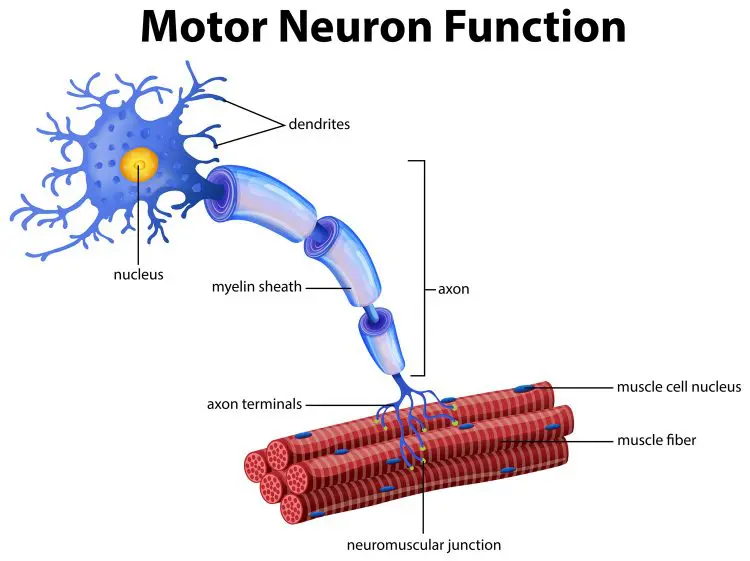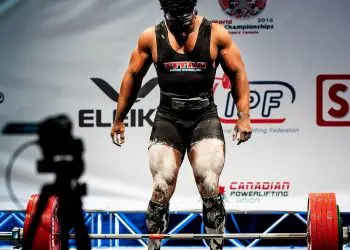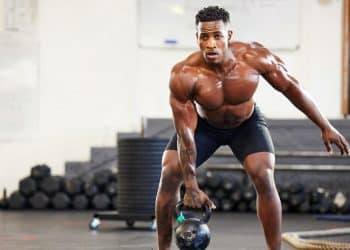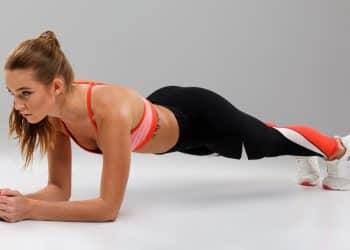Training for any sport is time-consuming. Not only do you need to find time to practice the skills of your chosen activity, but you also need to work on your strength and conditioning.
Depending on your sport, this can mean doing aerobic and anaerobic cardio, strength, power, and endurance training, agility, flexibility and balance work, and prehab and rehab for injury prevention.
Fitting all this stuff around school or a full-time job isn’t easy, which is why every athlete should seek out the most efficient and effective ways to achieve their training goals.
French contrast training is a very time-efficient training method that’s perfect for athletes from all sports. It combines two proven training methods to build strength, power, and muscle size at the same time.
In this article, we explain what French contrast training is, how it works and provide you with a weekly workout plan to follow.
What is French Contrast Training?
French contrast training, or FCT for short, is a strength and power workout built around two different but related workout methods:
Level Up Your Fitness: Join our 💪 strong community in Fitness Volt Newsletter. Get daily inspiration, expert-backed workouts, nutrition tips, the latest in strength sports, and the support you need to reach your goals. Subscribe for free!
- Complex training: A strength exercise followed by a power exercise.
- Contrast training: A heavy exercise followed by a light exercise.
It was invented by professional French track and field coach Giles Cometti and is designed to produce muscular and neurological adaptions for improved sporting performance (1). If you want to run faster, punch harder, or jump higher, FCT can help.
As an added benefit, FCT builds lean muscle and may even improve body composition by lowering body fat.
A French contrast workout involves four exercises done in a loose circuit format. While each movement is similar and involves roughly the same movement pattern, each exercise uses different loading parameters and movement speeds.
This challenges and develops multiple fitness components at the same time, i.e.:
- Big compound strength movement, e.g., barbell back squat (80-90% 1RM).
- High force plyometric or speed movement, e.g., squat jumps.
- Speed-strength movement, e.g., power clean (30% 1RM).
- Deloaded plyometric or speed movement, e.g., 10 to 15-meter sprint.
French contrast training can be used to train all body parts but is usually most effective when applied to movement patterns rather than individual muscle groups. For example, you may use FCT to improve hip and/or knee extension for running and jumping or horizontal and vertical pushes for improved upper body strength and power.
FCT crams a lot of high-quality work into a short space of time, making it ideal for busy athletes who also need to attend regular team practices. Because the workouts are short, they’re relatively easy to recover from, so they shouldn’t adversely affect sports skill training.
While French contrast training was developed for athletes, it’s also a great training system for recreational exercisers looking for a fun and effective way to shake up their workouts.
How Does French Contrast Training Work?
French contrast training affects your nervous system as much as your muscles. In fact, this effect on your nervous system is what makes this such a powerful training system. To understand how FCT works, you first need to know a little about the organization and function of the neuromuscular system…
Muscles are made up of multiple bundles of muscle fibers. These muscle fibers are then grouped into motor units. Each motor unit is controlled by a single motor neuron or nerve. These motor units either work at 100% of their contractile ability or do not work at all; this is known as the all-or-nothing law.

To alter the amount of force produced, your body recruits or innervates more or less motor units to achieve its goal.
For example, if you need to lift a heavy weight, your body fires off a lot of motor units. But, in the case of low resistance, fewer motor units are recruited.
The maximum amount of force you can produce is limited by the number of motor units you can recruit at once.
Untrained people can usually only recruit a small number of motor units. In contrast, well-trained individuals can recruit more. With training, your body learns to recruit more motor units so you can produce more force.
While it’s true that larger muscle fibers have the potential to generate more force, your nervous system is equally responsible for force production. This helps to explain why it’s possible to be small and strong or big but weak. Strength and power are determined by neurological fitness as much as muscle size.
So how does FCT make you stronger? Good question!
FCT improves a neurological function called post-activation potentiation, or PAP for short. PAP teaches your body to recruit more motor units.
Basically, the heavy exercises fire up your muscles, and they respond by recruiting more force in the subsequent plyometric or speed exercises. This “wave” of heavy and light training is repeated again during the second pair of movements, resulting in even greater force production.
Level Up Your Fitness: Join our 💪 strong community in Fitness Volt Newsletter. Get daily inspiration, expert-backed workouts, nutrition tips, the latest in strength sports, and the support you need to reach your goals. Subscribe for free!
If you have ever tried to lift what you thought was a heavy object only to discover it was a lot lighter than expected, you have already experienced the PAP effect in action.
Because you thought you were going to have to lift a heavy object, you mistakenly recruited far more motor units than you needed for the task at hand. As such, you lifted the object a lot faster than you probably intended.
FCT trains and teaches you how to recruit more muscle fibers on demand. The result is increased strength, power, athleticism, and functional hypertrophy.
French Contrast Training Workouts
Now that you know how FCT works, you’re probably ready to try it yourself. You could put your own FCT workout together but, to save you the time, we’ve written one for you.
Of course, before you hit the weights, you must spend a few minutes preparing your muscles and joints for what you’re about to do. Begin with 5-10 minutes of easy cardio followed by some dynamic mobility and flexibility exercises for the body parts you’re going to train.
Finish off your warm-up with a few ramped sets to acclimate your muscles to the weights you’ll be lifting and the exercises you’re about to perform. E.g., for bench presses, do:
- 10 reps 20kg (empty barbell)
- 8 reps 40kg
- 5 reps 60kg
- 2 reps 80kg
- 5 reps 100kg (1st work set)
While FCT forms the backbone of each session, we’ve also included some supplementary exercises to fill any gaps not covered in the main workouts.
Workout 1 – Knee Dominant (Squat Pattern)
| Exercise | Sets | Reps | Recovery | |
| 1a | Back squat (80% 1RM) | 3-5 | 3-5 | 15-20 seconds between exercises, 3-5 minutes between laps |
| 1b | Box jump | |||
| 1c | Dumbbell squat jump (30% 1RM) | |||
| 1d | Band-assisted squat jump | |||
| 2 | Standing calf raise | 2-3 | 8-12 | 60-90 seconds |
| 3 | Rollouts | 2-3 | 8-12 | 60-90 seconds |
| 4 | Pallof press | 2-3 | 8-12 | 60-90 seconds |
Workout 2 – Vertical Push (Overhead Press)
| Exercise | Sets | Reps | Recovery | |
| 1a | Military press (80% 1RM) | 3-5 | 3-5 | 15-20 seconds between exercises, 3-5 minutes between laps |
| 1b | Medicine ball vertical throw | |||
| 1c | Push-press (30%1RM) | |||
| 1d | Split jerk | |||
| 2 | Pull-up | 2-3 | 8-12 | 60-90 seconds |
| 3 | Dips | 2-3 | 8-12 | 60-90 seconds |
| 4 | Barbell biceps curl | 2-3 | 8-12 | 60-90 seconds |
Workout 3 – Hip Dominant
| Exercise | Sets | Reps | Recovery | |
| 1a | Deadlift (80% 1RM) | 3-5 | 3-5 | 15-20 seconds between exercises, 3-5 minutes between laps |
| 1b | Standing broad jump | |||
| 1c | Power clean (30% 1RM) | |||
| 1d | Kettlebell swing | |||
| 2 | Seated calf raise | 2-3 | 8-12 | 60-90 seconds |
| 3 | Hanging leg raise | 2-3 | 8-12 | 60-90 seconds |
| 4 | Dumbbell side bend | 2-3 | 8-12 | 60-90 seconds |
Workout 4 – Horizontal Push
| Exercise | Sets | Reps | Recovery | |
| 1a | Bench press (80% 1RM) | 3-5 | 3-5 | 15-20 seconds between exercises, 3-5 minutes between laps |
| 1b | Plyo push-up | |||
| 1c | Dumbbell bench press (30% 1RM) | |||
| 1d | Smith machine bench press throw | |||
| 2 | Seated cable row | 2-3 | 8-12 | 60-90 seconds |
| 3 | Dumbbell shoulder press | 2-3 | 8-12 | 60-90 seconds |
| 4 | Dumbbell biceps curl | 2-3 | 8-12 | 60-90 seconds |
French Contrast Training Guidelines
Get the most from your FCT workouts by following these guidelines:
1. This is NOT a conditioning workout!
Just because FCT looks like circuit training does not mean you should rush from one exercise to the next. Instead, take your time, catch your breath, and make sure that cardiovascular fatigue does not impede the performance of the exercises.
If in doubt, go a little slower to ensure that you can give each exercise maximum effort. If you are very out of breath, you are not taking enough time between exercises or laps, which will compromise the effectiveness of the workout.
2. Low reps, maximum effort
Despite doing only 3-5 reps per set, you should still put everything into each exercise. Do all your reps as powerfully as possible, attempting to move the weight as fast as you can. Avoid grinding out the reps and stop your set if you notice that movement velocity is starting to decrease. Training slowly trains you to go slower!
3. Stop short of failure
While there is a time and place for training to failure, FCT is not it. Training to failure invariably means slowing your rep speed, and you may even experience some form breakdown.
FCT works best when you focus on movement quality rather than quantity. It’s always better to stop your set with a couple of reps left in the tank so you can put more into the following exercise(s).
4. Try complexes first
If you are new to this type of training, ease yourself in with a few weeks of complexes. A complex is a strength exercise paired with a similar power exercise and is considerably less demanding than full French contrast training. Complexes are still challenging and productive but far more forgiving than FCT.
Examples of complexes include:
- Bench press + plyo push-ups
- Deadlifts + power cleans
- Pull-ups + medicine ball slams
- Squats + squat jumps
5. Don’t do FCT too long without a break
Despite being built around short workouts, FCT is very intense and will take its toll on your muscular and nervous systems. So, don’t do it for too long without a break, or your performance may start regressing.
French contrast training works best when done in 4 to 6-week blocks. Follow our (or your own) FCT workout for a month or so and then enjoy an easy deload week. This will help you to avoid overtraining and overuse injuries.
6. Increase load and volume gradually
FCT is a lot more taxing than it looks. As such, you should avoid doing too much too soon. Start with weights that are well within your abilities and do relatively few sets – 2-3 is plenty. Then, as you become more accustomed to this type of workout, you can gradually increase training load and volume.
However, remember that the first couple of sets are the most productive, and subsequent sets have a far smaller impact on your strength and power. Also, as well as being less effective, those extra sets produce more fatigue and take longer to recover from. As such, you may get better results from doing fewer sets.
French Contrast Method – Wrapping Up
French Contrast Training is an effective and time-efficient way to build strength and power. It combines heavy strength training with lighter, explosive power training exercises to enhance post-activation potentiation or PAP. This teaches you to recruit more motor units for better force development. Combining complex and contrast training, FCT is a very practical training system.
On the downside, FCT is very demanding, so it’s not really suitable for beginners or anyone with poor recovery abilities. Even more advanced exercisers should keep their FCT workouts short and blocks of training to about 4-6 weeks before taking a deload week.
That said, French contrast training is ideal for athletes looking to build strength and power in the most time-efficient way possible. It’s perfect for anyone who cannot commit to more time-consuming types of training.
References:
1– PubMed: Effect of the French Contrast Method on Explosive Strength and Kinematic Parameters of the Triple Jump Among Female College Athletes https://www.ncbi.nlm.nih.gov/pmc/articles/PMC6815088/











